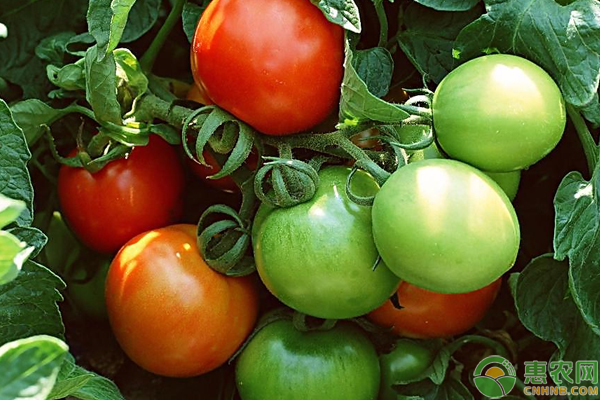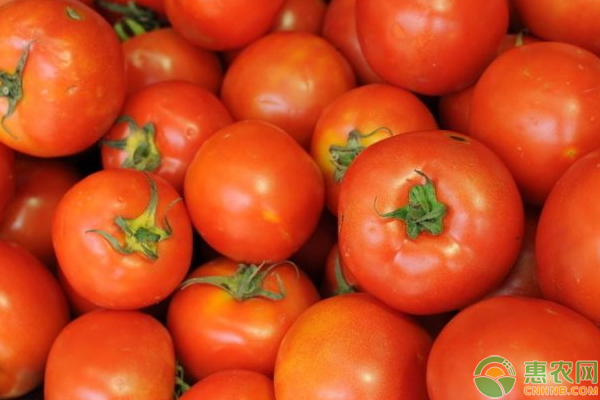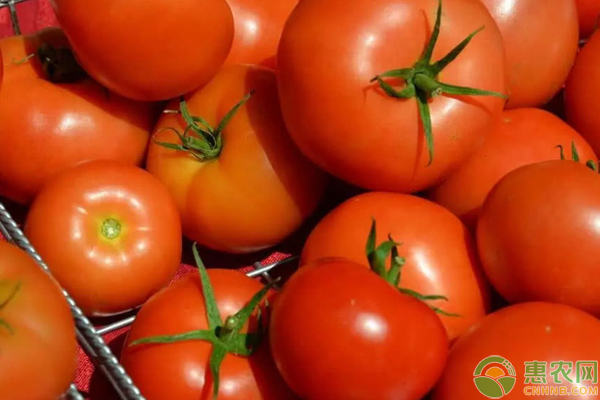It is a common phenomenon to plant flowers and fruits in tomatoes. However, if it is not solved in time, the quality of tomatoes will be poor. In severe cases, production will be reduced. Many growers ask why Xiaobian has this phenomenon. In fact, it is improper management of fertilizer and water. It is a detailed high-quality and high-yield fertilization measure for tomatoes, and you can refer to them. 1. Tomato fertilization technology (1) Fertilization principle Tomato fertilization should be combined with organic fertilizer and chemical fertilizer, heavy application of base fertilizer, and skillful application of topdressing. The seedling stage should be based on nitrogen fertilizer, and pay attention to the application of phosphate fertilizer, which can promote the expansion of leaf area and flower bud differentiation. The flowering period of the first spike should gradually increase nitrogen and potassium nutrition. At the peak of the period, on the basis of sufficient supply of nitrogen and potassium, it is necessary to increase the nutrition of phosphorus, especially in protected areas, pay more attention to the supply of nitrogen and potassium, and also increase the application of CO2 gas fertilizer and calcium, magnesium, boron and sulfur. And medium-sized elements such as iron and trace element fertilizers - cytosolic combination.     (2) Recommended fertilization program Tomato cultivation methods can be divided into open-field cultivation and protected cultivation, and the amount of fertilizer needed for conservation cultivation is slightly larger. Therefore, tomato fertilization is slightly different depending on the cultivation method and target yield. In areas with soil analysis and testing conditions, the soil nutrient abundance status and field fertilizer efficiency test should be combined with existing experience to determine the amount of fertilizer applied, which can make the fertilizer application more accurate and better.     1 open field cultivation of tomatoes for fertilization     A. Nursery and fertilization Fertilizer application in the preparation of nursery soil: 6 parts of garden soil without planting solanaceous vegetables, 4 parts of decomposed organic fertilizer, seedling tray seedlings can be used for vermiculite, nutrient soil and other substrates, and the nutrient soil can be sieved with 7 parts of cooked soil. 3 parts of sifted decomposed organic fertilizer were mixed. If the seedlings grow slowly, they can be added with Harvey; if there is a long phenomenon, spray Harvey flowers.     B. Heavy application of base fertilizer Combined with shallow turning, apply 2500~3000kg of composted compost or 400~450kg of commercial organic fertilizer per mu, 5~6kg of urea, 13~18kg of diammonium phosphate, 6~8kg of potassium sulfate or potassium chloride.     C. skillfully applying top dressing After planting the field, the fertilizer is generally applied 4 times. The first time is to send the tree fertilizer, generally 10 to 15 days after planting, combined with watering per mu, 40 to 500 kilograms of decomposed organic fertilizer or 4 kilograms or root fertilizer of Harvey Zhuang (30-10-10-TE). Get 4 liters; The second time is to promote fruit fertilizer, generally in the first ear of fruit began to expand, usually the amount of topdressing accounted for about 35% of the total amount of topdressing. Topdressing is mainly based on nitrogen, and 800-1000 kg of decomposed organic fertilizer per mu or 4 kg of Harvey (20-20-20-TE); The third time is Shengguofei, which is harvested in the first ear fruit, applied when the second ear fruit is inflated, and 800~1000 kg of organic fertilizer per acre or 4 kg of Harvey fruit (5-5-45-TE); The fourth time is the anti-early-fat fertilizer, which is carried out at the time of harvesting the second ear fruit. The top dressing is 2 kg Harvey + 2 kg Harvey fruit per mu. In the spring, 4 times of topdressing can meet the needs of various nutrients. If it is cultivated in the summer, it will be applied to 4 kilograms of Qavihua (10-45-10-TE) per acre after summer, which will promote the rapid growth of plants and form a second harvest peak. Kilogram of water soluble fertilizer, Harvey and Harvey fruit are used interchangeably. In order to improve the quality and prolong the result period, foliar topdressing can be carried out, and the hardness and storability of the fruit can be improved by spraying 9 or 750 times of Nippon and 750 times of New Zealand calcium and boron.     2 Protected cultivation of tomato fertilization     A. Fertilization at seedling stage When preparing nutrient soil, 1.0 kg of ammonium sulfate, 1.0 kg of calcium magnesium phosphate, and 5 kg of grass ash were added per cubic meter of matrix. The seedbed soil can be mixed according to the ratio of 4 parts of paddy soil and 6 parts of organic fertilizer. The amount of nitrogen, phosphorus and potassium in the cubic meters of soil is 15~15:15. The vegetable ternary compound fertilizer is 2~3 kg. .     B. Heavy application of base fertilizer The growth of tomatoes is large, the yield is high, and the amount of fertilizer is large. The base fertilizer should be applied before planting. According to the high-yield and high-quality experience of each vegetable area, under the general soil fertility level, it can be applied with 3000~3500 kg of decomposed organic fertilizer per acre, deep-turning to mix the loam, and ditch 10~15 cm to apply a balanced compound. Fertilizer (15:15:15) 80~100 kg, and add 2kg of medium and trace element fertilizer nucleus per acre in the protected area to reduce the deficiency that may occur during tomato growth.     C. skillfully applying top dressing The principle of topdressing is from small to large, from thin to thick, with nitrogen as the main stage and phosphorus and potassium in the middle and late stages. For the first time, it is a fertilizer, usually 10 to 15 days after planting, 4 liters of root fertilizer combined with watering or 4 kilograms per acre of Harvey Zhuang (30-10-10-TE). The second time is the application of fruit fertilizer, Shihaweitong (20-20-20-TE) 4 kg when the first ear fruit begins to expand; it can also be applied to the cake fertilizer or the decomposed manure 500~600kg, and with potassium sulfate 8~l0kg. The third time is to apply the fruit fertilizer, after the first ear fruit is harvested, the second ear fruit is applied when it is enlarged. Generally, Schawi fruit (5-5-45-TE) 4 kg, or completely dilute the dilute manure or bean cake fertilizer (diluted 10 to 20 times water) l000 ~ 1500 kg. The fourth and fifth anti-early-fat fertilizers are generally used to apply 1000-1500 kg of dilute urine fertilizer or 2 kg of Harvey pass + 2 kg of Harvey fruit per acre.     2. Common deficiency and remedial measures     (1) nitrogen deficiency Symptoms In the absence of nitrogen at seedling stage, the plants grow slowly, the flower buds are less differentiated, the stems are small, the leaves are thin and the leaves are light green, and the vegetative growth is inhibited; The leaves are small and thin, and the veins change from yellow-green to deep purple. The main stem becomes hard and dark purple, the buds and flowers become pale yellow, the roots are poorly developed, the flowers are easy to fall, the deformed fruits are more, the lower functional leaves are easy to yellow and fall off, the plants are prone to premature aging, and the result period is shortened. Tomatoes have small and small ears and small fruits. Remedial measures When the nitrogen is deficient, foliar spray 750 times Harvey Zhuang (30-10-10-TE), or use human excrement plus appropriate amount of urea plus water to dilute the pouring or acupoint application.     (2) Phosphorus deficiency Symptoms of seedlings are blocked by phosphorus deficiency, the stems are weak and purple-red, the leaves are small and hard, and some small purple-purple spots appear on the veins, and then gradually spread to the whole leaf. The veins and petioles also develop purple, and flower bud differentiation cannot be performed. , seriously affecting the formation of later production. It also reduces the quality of the fruit. Excessive phosphorus can also cause abnormalities. The remedial measures are evenly sprayed with 750 times of liquid of Harvey flower per acre, sprayed once every 5-7 days, and used continuously for 2-3 times.     (3) Potassium deficiency Symptoms The young leaves are curled, the old leaves are initially grayish green, and then the leaf edges turn yellow-green until the leaves are dry and the leaves curl upward. Sometimes the veins are chlorotic or necrotic, and even expand to new leaves. More fruit, more cracked fruit and more empty fruit, mature late. During the flowering period, if the soil is dry, it is prone to potassium deficiency. Remedial measures should be applied in time to apply potassium fertilizer, spray evenly with 750 times of Harvey fruit per acre, spray once every 5-7 days, and use 2-3 times continuously. At present, high-yield and high-yield fertilization measures for tomatoes solve the problem of falling flowers, falling fruits, cracked fruits and hollow fruits!     (4) calcium deficiency Symptoms The upper leaves of the tomatoes turn yellow, the leaf margins are heavier, the necrosis gradually turns brown, the top buds are easy to die, the young leaves are small, and they become purple-brown and die. The leaves are curled, the stems are weak, and the branches are drooping. The flower at the top of the inflorescence is prone to death, the growth point, the ovary are withered or atrophied, and the fruit is prone to umbilical rot and black. The root group is thicker and shorter, more branched, often brownish brown. The remedy is to spray 9,750 times of Nefopae or 750 times of New Zealand calcium and boron at the initial stage of fruit setting. In addition, if the umbilical rot fruit is found in the young fruit period, it should be removed in time to reduce the nutrient consumption in the plant and ensure the growth of the fruit.     (5) Magnesium deficiency Symptoms The middle and lower leaves of the plant are chlorotic and yellow, and gradually develop into the whole plant leaves. Only the main veins remain green, and there are often small narrow green edges around the small leaves. In severe cases, the veins sag, the discoloration is enlarged, the plaque or death occurs, the fruit is small, the yield is low, and the quality is poor. Remedial measures Use 750 times solution of New Zealand Magnesium to spray evenly. At present, high-yield and high-yield fertilization measures for tomatoes solve the problem of falling flowers, falling fruits, cracked fruits and hollow fruits!     (6) Iron deficiency Symptoms The young leaves in the upper part of the plant begin to develop severe chlorosis. The top leaves first appear grayish yellow spots, then spread outward along the veins, causing rot or death in the upper part of the leaves. Remedy Foliar surface is sprayed evenly with 750 times of New Zealand iron. (7) Boron deficiency Symptoms The growth point of the stem becomes black, the top buds die, and new branches and leaves grow near the growth point, and the plants are clustered. The top branches are curled inward and yellow is prone to death. Remedial measures 750 times of uniform leaf spray per acre of New Zealand boron or New Zealand calcium boron, once every 7 to 10 days, even spray 2~3 times.     (8) zinc deficiency Symptoms New leaves are particularly small, yellow or have spots, commonly known as "lobular disease." Remedial measures Apply 750 times solution of New Zealand zinc per acre to spray evenly.     (9) Copper deficiency Symptoms The plants grow slowly, the leaves curl inward, lose green, and the stems and leaves lose their firmness and cannot form flower buds. Branch growth is inhibited and roots are poorly developed. Remedial measures Apply 750 times of New Zealand copper per acre to spray evenly.     (10) Manganese deficiency Symptoms Plant growth is blocked, neither flowering nor fruitful. Remedial measures Apply 750 times of New Zealand copper per acre to spray evenly. Whether the crop growth is high or not, the key factor is the management of water and fertilizer. The above is the method of planting and skillfully planting tomatoes. Tuna Hamburger,Tuna Sushi,Tuna Products Zhejiang Ocean Family Co., Ltd., , https://www.ocean-family.com

